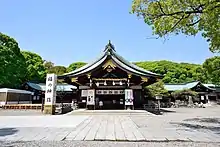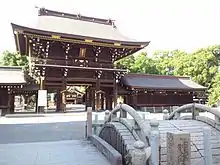Masumida Shrine
Masumida Shrine (真清田神社, Masumida Jinja) is a Shinto shrine in the city of Ichinomiya in Aichi Prefecture, Japan. As the name of the city implies, the shrine is the ichinomiya of former Owari Province. The main festival of the shrine is held annually on April 3.
| Masumida Shrine 真清田神社 | |
|---|---|
 Haiden of Masumida Shrine | |
| Religion | |
| Affiliation | Shinto |
| Deity | Amenoho no Akari no mikoto |
| Festival | April 3 |
| Location | |
| Location | 1-2-1, Masumida, Ichinomiya, Aichi 491-0043 |
 Shown within Aichi Prefecture  Masumida Shrine (Japan) | |
| Geographic coordinates | 35°18′27″N 136°48′07″E |
| Architecture | |
| Date established | unknown |
| Website | |
| Official website | |

Enshrined kami
The primary kami of Masumida Jinja is Amenoho no Akari no mikoto (天火明命), who appears in the Kujiki as a descendant of Amaterasu, and the ancestor of the Owari clan, the prehistoric rulers of the area.
History
The date of Masumida Shrine's foundation is unknown. Shrine tradition and the Kujiki records give the unlikely date of 628 BC, or the third day of the third month of the 33rd year in the reign of Emperor Jimmu. Another tradition gives the date of foundation to the reign of the semi-legendary Emperor Suinin (97 BC – 30 BC). The shrine is located near the site of the provincial capital of Owari Province, established in the Nara period and features in the Yamato Takeru myth cycle. During the early Heian period, it appears in the Engishiki records. It has been styled as the ichinomiya of Owari Province since at least the end of the Heian period.
In 1584, after the shrine was damaged by an earthquake, it was rebuilt by Toyotomi Hideyoshi. It was subsequently supported by the Tokugawa shogunate and Owari Domain until the end of the Edo period. After the Meiji Restoration, the shrine was classed as a Kokuhei Chūsha (2nd rank National Shrine) under State Shinto in 1875.[1] The shrine was destroyed in the Ichinomiya air raid of 1945 and was not rebuilt until 1951, with reconstruction taking ten years. Four of the shrine buildings are Registered Tangible Cultural Properties
The shrine preserves a number of National Important Cultural Properties of Japan, including:
- 12 wooden kagura masks, ten from the Kamakura period, two from the Muromachi period, donation from Juntoku Tenno
- 25 lacquer trays and bowls, dated 1457
- 22 ceremonial bronze bowls and plates, dated 1574
References
- Plutschow, Herbe. (1996). Matsuri: The Festivals of Japan. London: RoutledgeCurzon.ISBN 1-873-41063-8
- Ponsonby-Fane, Richard Arthur Brabazon. (1959). The Imperial House of Japan. Kyoto: Ponsonby Memorial Society. OCLC 194887
External links
| Wikimedia Commons has media related to Masumida Shrine. |
- Masumida Shrine (Official site)
- Aichi Prefecture tourist information
Notes
- Ponsonby-Fane, Richard. (1959). The Imperial House of Japan, pp. 125.